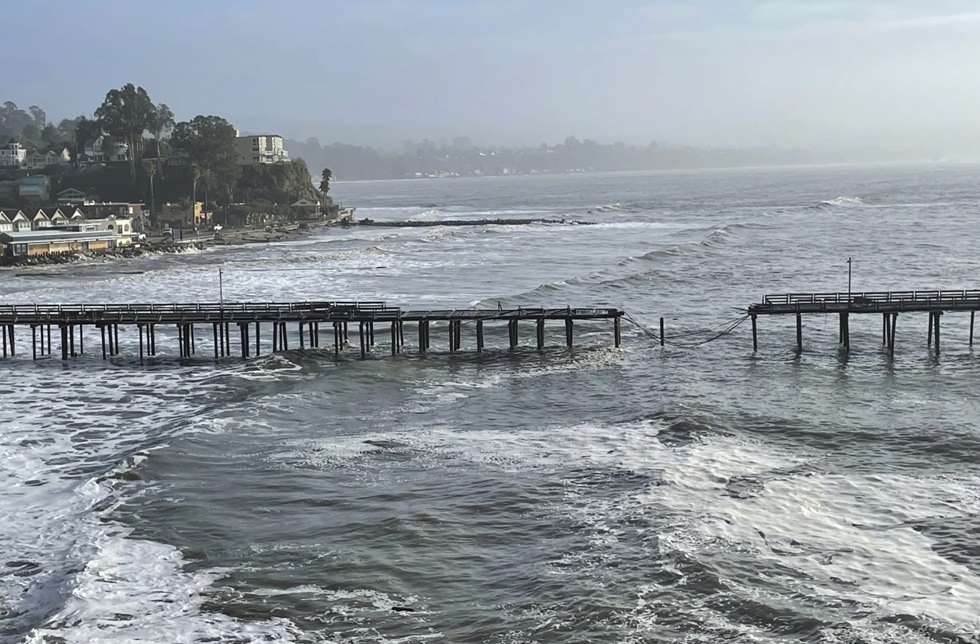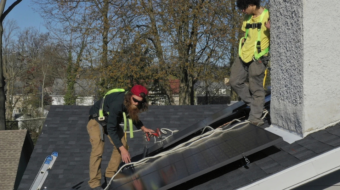
SAN DIEGO (AP) — More storms, rising seas, and huge waves are taking their toll on California’s iconic piers that have dotted the Pacific coast since the Gold Rush, posing the biggest threat yet to the beach landmarks that have become a quintessential part of the landscape.
At least a half dozen public piers are closed after being damaged repeatedly by storms over the past two years. Repair costs have climbed into the millions of dollars.
Among those shuttered is the pier in Capitola built in 1857 that predates the northern California town and is a popular spot to watch passing whales and dolphins. Another damaged by storms in San Diego, the Ocean Beach pier, offers a bird’s eye view of surfers carving waves below.
More damage is possible this year with El Nino, which is expected to bring additional storms to California caused by the temporary warming of parts of the Pacific that changes weather worldwide. Back-to-back atmospheric rivers began drenching California on Friday.
City engineers are looking at redesigning piers to withstand bigger surf with a rise in sea levels. Others face relocation or removal.
“We are very much in a changed environment,” said Mike Beck, director of the Center for Coastal Climate Resilience at the University of California, Santa Cruz. “And we’re not going to be able to rebuild back in the same places and in the same ways that we did before. We’re going to have to think more clearly about how we design and where we put these.”
Most piers have undergone major repairs after enduring everything from fires to erosion. But officials say they are now being damaged at an unprecedented rate.
Waves rising to heights topping 20 feet (6 meters) in late December pummeled the 855-foot-long (260.6-meter) Capitola Wharf in Santa Cruz County, only months after repairs following storms in January 2023 that collapsed a large section. The Capitola Wharf is a pier by nautical standards since it runs perpendicular to the shore, versus a traditional wharf running parallel.
San Diego’s Ocean Beach pier, a nearly 2,000-foot (609.6-meter) concrete structure built in 1966, has been repeatedly battered since 2019. The pier was still undergoing repairs after beatings from high surf that closed it twice last year when a monster swell in January wiped away a piling.
The city is exploring replacing the structure after spending more than $1.7 million in fixes over the past five years. It has secured $8.4 million in state funds for a new one. Among the three proposed designs is one with interconnected pathways, giving it a different look.
California’s state park service demolished the 93-year-old pier at Seaside State Beach near Aptos in Santa Cruz County after a January 2023 storm surge smashed it in half.
Communities are grappling with whether they can afford to keep their piers, which will need taller and stronger pilings that could make their historic look more industrial, Beck said.
But those are tough conversations for many who consider the piers almost sacred.
“It’s sometimes a little bit of a funny thing here in California, the way that we love our piers,” he said.
For generations, the structures have provided families, fishers, tourists, and others a peaceful place to experience the ocean without getting wet.
In Ventura, west of Los Angeles, the Visitors & Convention Bureau waxes poetic about the pier built in 1872 that it calls the city’s centerpiece.
“Walk Ventura’s beaches and, in the distance, it wavers like a child’s matchstick project,” the bureau states on its website. “Sit on the sand at its base (on a calm day) and it whispers a lovely song any ocean (and pier) lover knows.”
California’s oldest piers served steamships and were lifelines for settlements to get lumber, bricks, and cement with much of the coast decades from being reached by a railroad. Piers were later built for tourism like the Santa Monica pier, which has an amusement park with the world’s first solar-powered Ferris Wheel.
In December, Ventura’s pier already was undergoing repairs from the January 2023 storms when the monster swell that damaged San Diego’s pier around New Year’s Eve also wiped away or damaged 19 pilings supporting Ventura’s pier.
Rising sea levels from global warming are causing the waves to be bigger off California’s coast, according to research. The coast is also seeing some of the highest tides of the season.
“We’re really seeing the confluence of all these factors coming together. And that’s going to keep happening,” Beck said. “And here in an El Nino year as well, we also see increases in sea levels, even over and above the kinds of increases that we predict long term with sea level rise.”
During a visit to Capitola last year to assess California’s widespread storm damage, President Joe Biden said global warming is challenging rebuilding efforts.
Capitola’s Public Works Director Jessica Kahn said climate change was taken into account for its $8 million pier project slated for completion this fall.
“The city went over many iterations and different designs and different tactics to make the wharf more resilient and finally settled on widening the wharf,” she said, adding that the narrow part of the trestle will go from three to six pilings.
The new pilings also will have the ability to be raised as sea levels go up.
Kahn said she has no doubt it is worth investing millions to preserve a relic of the past whose sole purpose today is for pleasure, given the number of memories soaked into the wooden wharf.
“When we had our damage here this past January of 2023, you would not believe the amount of phone calls we got. We got obviously from people nearby, but from people who come here annually, people who are out of the country,” she said.
Over the years, Inge Jechart has spent time on the pier gazing down at schools of anchovies being chased by seals as birds circle overhead.
As it undergoes repairs, she now stands on a bluff to watch the crews.
“I think they’re going to do a great job. Yes, we’re having stronger storms, and the weather is changing. But I think we can do it so that it’ll last longer,” she said. “And I think it’s absolutely worth it. It brings a community together. People love walking out there.”
We hope you appreciated this article. At People’s World, we believe news and information should be free and accessible to all, but we need your help. Our journalism is free of corporate influence and paywalls because we are totally reader-supported. Only you, our readers and supporters, make this possible. If you enjoy reading People’s World and the stories we bring you, please support our work by donating or becoming a monthly sustainer today. Thank you!











